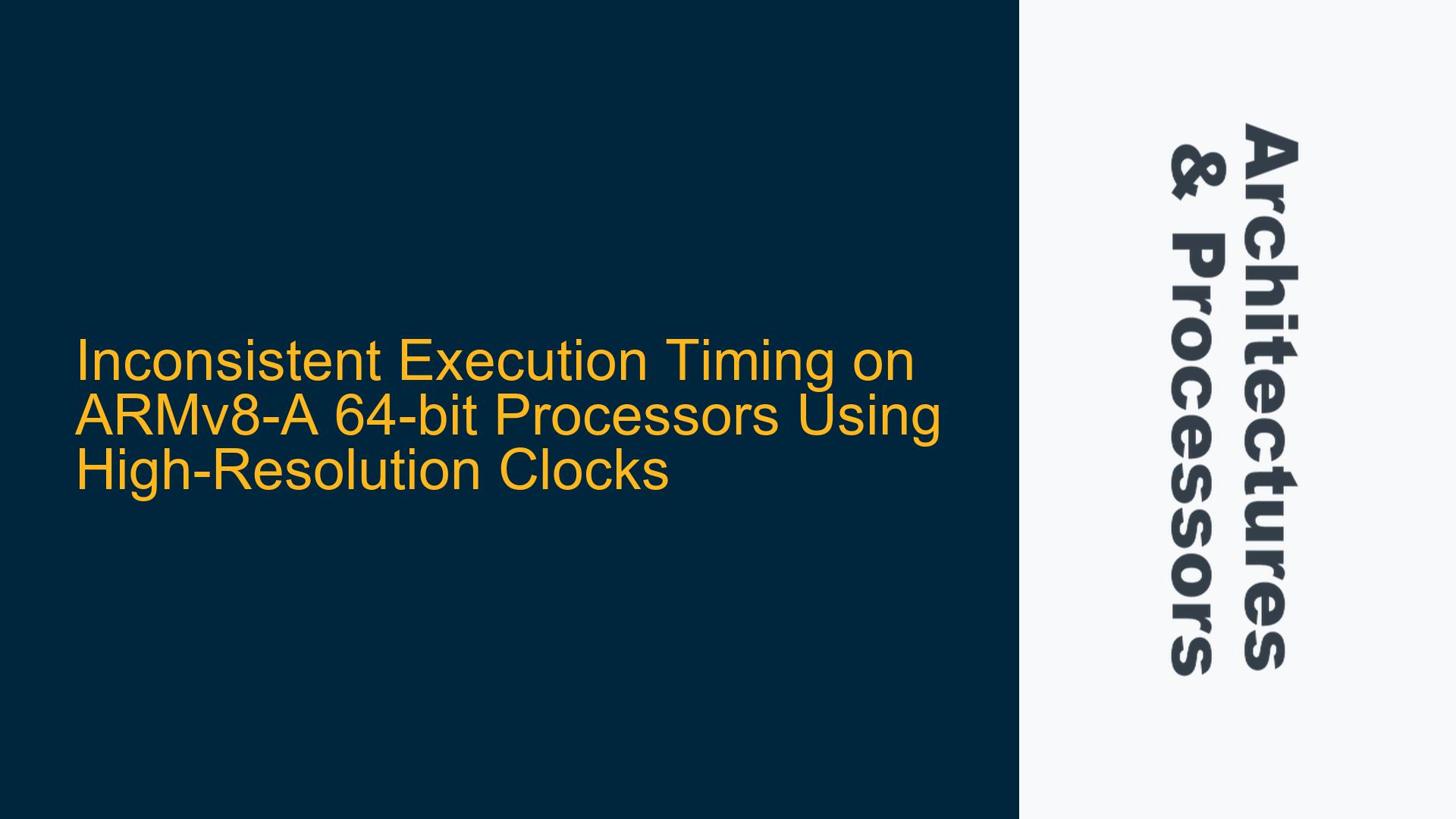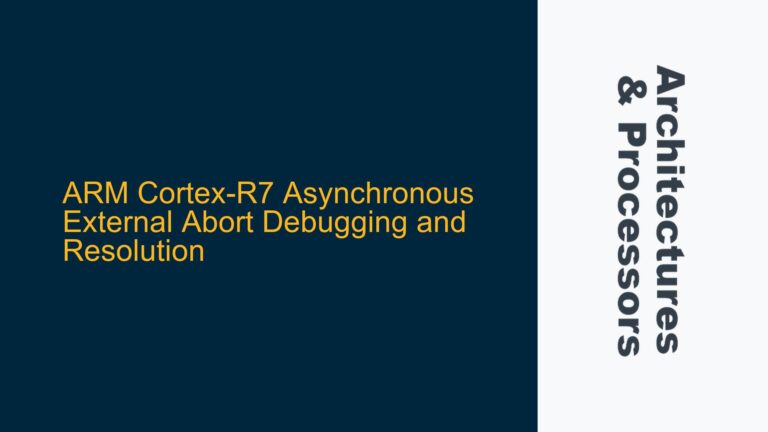ARMv8-A 64-bit Processors and Volatile Execution Timing
When working with ARMv8-A 64-bit processors, one of the most common challenges developers face is accurately measuring the execution time of programs. This issue is particularly pronounced when using high-resolution clocks, such as std::chrono in C++, which are commonly used on Intel processors. On ARMv8-A architectures, the execution time of the same program can vary significantly between runs, leading to inconsistent and unreliable timing measurements. This volatility can be attributed to several factors inherent to the ARM architecture, including the behavior of system timers, the impact of power management features, and the nuances of cache and memory subsystems.
The ARMv8-A architecture, while highly efficient and scalable, introduces complexities that are not as pronounced in x86 architectures. For instance, the ARM architecture’s reliance on system timer registers like cntpct_el0 and cntvct_el0 for timing measurements can be affected by frequency scaling, interrupt handling, and other system-level operations. Additionally, the ARM architecture’s power-saving features, such as dynamic voltage and frequency scaling (DVFS), can lead to variations in execution time. These factors, combined with the potential for cache misses and memory access latency, contribute to the observed volatility in timing measurements.
To address these challenges, it is essential to understand the underlying mechanisms of the ARMv8-A architecture and how they impact timing measurements. This includes a deep dive into the system timer registers, the role of the frequency register cntfrq_el0, and the implications of using high-resolution clocks like std::chrono on ARM processors. By gaining a comprehensive understanding of these elements, developers can implement more reliable timing mechanisms that account for the unique characteristics of ARMv8-A processors.
System Timer Registers and Frequency Scaling Impact
One of the primary causes of inconsistent execution timing on ARMv8-A 64-bit processors is the behavior of system timer registers and the impact of frequency scaling. The ARM architecture provides several system timer registers, including cntpct_el0 and cntvct_el0, which are used to measure elapsed time. These registers are incremented at a frequency defined by the cntfrq_el0 register, which specifies the clock frequency of the system timer.
However, the frequency at which these registers are incremented can be affected by frequency scaling, a power management feature that dynamically adjusts the clock speed of the processor based on the current workload. When the processor is under heavy load, the clock speed may increase to improve performance, while under light load, the clock speed may decrease to save power. This dynamic adjustment of the clock speed can lead to variations in the timing measurements obtained from the system timer registers, as the frequency at which the registers are incremented is not constant.
Additionally, the system timer registers themselves may be subject to delays caused by interrupt handling and other system-level operations. For example, if an interrupt occurs while the program is being timed, the processor may temporarily halt the execution of the program to handle the interrupt, leading to an increase in the measured execution time. Similarly, if the program accesses memory that is not currently in the cache, the resulting cache miss can introduce additional latency, further impacting the timing measurements.
To mitigate these issues, developers must account for the potential impact of frequency scaling and system-level operations on timing measurements. This may involve disabling frequency scaling during timing measurements, using more precise timing mechanisms, or implementing techniques to minimize the impact of interrupts and cache misses. By understanding the relationship between system timer registers, frequency scaling, and system-level operations, developers can achieve more consistent and reliable timing measurements on ARMv8-A processors.
Implementing Precise Timing Mechanisms with clock_gettime and Direct Register Access
To achieve more consistent and reliable timing measurements on ARMv8-A 64-bit processors, developers can implement precise timing mechanisms using both high-level and low-level approaches. One high-level approach is to use the clock_gettime function with the CLOCK_REALTIME clock source, which provides a high-resolution timestamp that can be used to measure execution time. This function is part of the POSIX real-time extensions and is supported by many operating systems, including Linux distributions like Linaro Debian.
The clock_gettime function works by querying the system clock, which is typically synchronized with the system timer registers. This allows developers to obtain a high-resolution timestamp that can be used to measure the elapsed time between two points in the program. However, it is important to note that the accuracy of clock_gettime can still be affected by factors such as frequency scaling and system-level operations, so it may not always provide the level of precision required for certain applications.
For applications that require even greater precision, developers can directly access the system timer registers, such as cntpct_el0 and cntvct_el0, to obtain a more accurate measurement of elapsed time. These registers provide a direct interface to the system timer, allowing developers to bypass some of the overhead associated with high-level timing functions. However, accessing these registers requires a deep understanding of the ARM architecture and may involve writing assembly code or using inline assembly in C/C++.
When using direct register access, developers must also consider the frequency of the system timer, which can be obtained by reading the cntfrq_el0 register. This frequency is used to convert the raw timer values obtained from cntpct_el0 or cntvct_el0 into a meaningful time measurement. By combining direct register access with an understanding of the system timer frequency, developers can achieve highly accurate and consistent timing measurements on ARMv8-A processors.
In addition to these techniques, developers should also consider the impact of cache and memory subsystems on timing measurements. For example, ensuring that the program’s data is cached before timing begins can help minimize the impact of cache misses on execution time. Similarly, using memory barriers to ensure that memory accesses are completed before timing begins can help reduce the impact of memory latency on timing measurements.
By implementing these precise timing mechanisms and accounting for the unique characteristics of the ARMv8-A architecture, developers can achieve more consistent and reliable timing measurements, even in the presence of frequency scaling, interrupts, and other system-level operations. This approach not only improves the accuracy of timing measurements but also provides a deeper understanding of the underlying hardware, enabling developers to optimize their code for better performance on ARMv8-A processors.






